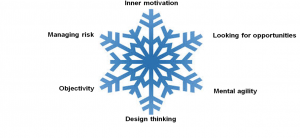The creativity job spec


Could you write a job spec for creativity?
David Perkins thinks that we can. Perkins is a senior professor of education who has studied creativity extensively. Back in the 1980s, he identified six related traits that mark out the creative person. He calls this ‘the snowflake model of creativity’. Creative people might not possess all six, he says; but the more they have, the more creative they tend to be.
The snowflake model has been much quoted and copied. In some cases, I’ve altered the names of Perkins’ traits. For each of the competencies, I’ve listed three key questions that you can ask yourself to help you develop your own aptitude in that area.
1. Inner motivation
This is perhaps the most important creative competency. In creative mode, we ignore pay cheques or qualifications. We’re driven by the challenge of the work itself: by intrinsic enjoyment and satisfaction of creating.
There’s a paradox here. Creating must have a purpose; yet it is its own justification.
– Inner motivation: questions to ask
What makes you curious?
What’s really important to you?
What’s dissatisfying you?
2. Looking for opportunities
Creatively competent people spot opportunities to be creative. In fact, they seek them out.
Creative people ask questions. Lots of them. By asking a good question, you might be able to see the current boundaries of your thinking – and break through them.
– Looking for opportunities: questions to ask
Are you overlooking an important issue?
Where are the problems hidden below the surface?
What if…?
3. Mental agility
Mental agility allows us to look at problems differently. Call it mental gymnastics: the ability to think in new directions, from new angles, and with new perspectives. The more ways we can look at something, the more ways we can deal with it.
Just as gymnastics is made up of different skills, mental agility involves different disciplines. Associative thinking, for example, looks for connections between things. Rule reversal challenges the assumptions underlying our thinking. And so on.
Mental agility looks for new connections between thoughts. It’s the new connections that provide the sparks of creative ideas.
– Mental agility: questions to ask
What does your idea remind you of?
What whacky or strange things could you do with your idea?
4. Design thinking
Where mental agility craves newness, design thinking craves simplicity. Design thinking cuts through disorder towards synthesis or resolution.
Albert Einstein was apparently once asked why he used hand soap for shaving. “Two soaps?” he replied. “That’s too complicated.”
– Design thinking: questions to ask
What’s your idea like?
What could you edit out of your idea or project?
How could you make your idea simpler?
5. Objectivity
The weird ideas of a psychotic may be highly original, but they’re hardly creative.
Truly creative ideas must have some value or use in the real world.
Genuinely creative people aren’t self-absorbed loners; they constantly seek feedback and criticism. They scrutinise and judge ideas, and ask others for their opinions. They put their egos to one side; they listen to advice and test their ideas.
– Objectivity: questions to ask
What assumptions are you making?
What’s wrong with your idea? Why won’t it work?
What could you do without?
6. Managing risk
Creative people share a love of risk with daredevils and criminals. They seek danger, excitement and stimulation. They bore easily. They also accept failure as part of the adventure.
Taking risks is never easy in organisations. Success may be celebrated; failure is unlikely to be forgotten. And failure can have unintended and unpleasant consequences. So we need to find ways of managing risk.
– Managing risk: the questions to ask
Where is fear holding you back?
What’s the worst that could happen?
How can you manage the possibility of the worst-case scenario?
Of course, creating is not just a set of competencies or skills. It’s a practice. The vital question is: “What do I want to create?”
If you want to learn how to become more creatively competent, take a look at my eBook, Creativity at Work.
About the author: Alan Barker is Managing Director of Kairos Training Limited, a training and coaching consultancy that helps people communicate and think more effectively. Alan is a member of the UK Speechwriters’ Guild and the European Speechwriter Network. He’s the author of Creativity at Work and How to Write an Essay.






